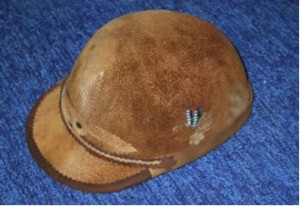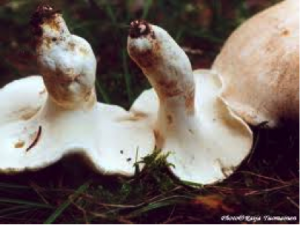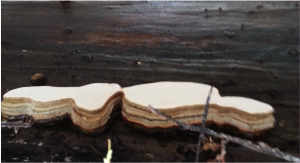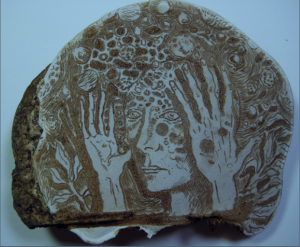By Mary Perkins
The fungus Fomes fomentarius (“tinder fungus”), though easy to pass without notice, has an array of wondrous qualities that should be recognized. These range from wood degraders, fire starters, clothing, weaponry, and medicinal uses. It has a long history of being used all around the globe, even dating back to the 5,000 year old Iceman, Otzi.
Lifestyle of the Fungi
Fomes fomentarius is a dark gray hoof-shaped (Lincoff, 1991) saprotrophic (lives on dead organic matter) fungus that grows on dead wood or wounded trees, mainly hardwoods, “. . . particularly fond of birch trees, although other trees, including firs, can be the host,” (Stamets, 2002). The most important role this polypore (the fertile tissue is composed of many pores rather than gills) fungus plays in ecology is the break-down of wood. It has the capability of degrading lignin, as a white rot. Wood is a very hard substance that only certain fungi can break down, Fomes fomentarius being one of them. They help rid the forest floor of litter, acting as nature’s recycler. Imagine how high a pile trees can reach if they were not decomposed. Not only do they clean up the forest floor, they help soften wood to make it possible for insects and nesters, such as birds and squirrels, to inhabit the trees (Bunnell & Houde. 2010).
Uses of Fomes fomentarius
Humans have had an intimate relationship with Fomes fomentarius for many years. They have utilized this fungus for medicinal purposes, carrying embers, fire starters, weaponry, and even clothing. The Okanagan-Colville natives used the fungus to make antimicrobial teas and poultices to treat infections and arthritis (Stamets, 2002). It was used to cauterize wounds by Laplanders and the Cree to treat frostbite (Rogers, 2011). The entire fruiting body can be hollowed out to carry embers while travelling from one camp t o another. The inside of the fungus can be dried and is easy to light with only a spark. The fungus was also used to discharge guns, from the spark of the flint, to the fungus, to the gunpowder (Stamets. 2002). When the fruiting body is smashed it becomes felt-like, usable for clothing materials, such as this fashionable hat, (see photo).
o another. The inside of the fungus can be dried and is easy to light with only a spark. The fungus was also used to discharge guns, from the spark of the flint, to the fungus, to the gunpowder (Stamets. 2002). When the fruiting body is smashed it becomes felt-like, usable for clothing materials, such as this fashionable hat, (see photo).
Evidence of the use of the tinder fungus has been found dating as far back as the Iceman, Otzi. A 5,000 year old mummy was found, preserved in ice, with his clothing and tools. Among these objects was Fomes fomentarius along with flints, as part of his, “fire-making kit,” (Moore et. al, 2013). It is amazing to think that the same use of the same fungus has been in practice for so many years, covering a vast area and peoples. We are similar beyond borders.
The tinder fungus plays many roles. It is important to forest ecology as well as beneficial to humans. It is a decomposer and a homemaker. It can be weaponized or create warmth and healing. It may not be a pretty fungus but there is more than meets the eye.
References:
Arora, D. 1986. Mushrooms demystified. New York: Random House
Bunnell, F. L., & Houde, I. (2010). Down wood and biodiversity – implications to forest practices. Environmental Reviews, 18(1), 397-421. doi:10.1139/A10-019
Lincoff, G., Knopf, A. 1991.The Audubon society field guide to North American mushrooms. New York: Knopf
Moore, D., Robson, G.D., Trinci, A.P.J. 2013. 21st century guidebook to fungi. New York: Cambridge University Press
Rogers, R. 2011. Fungal pharmacy. Berkeley, CA: North Atlantic Books
Stamets, P. 2002. MycoMedicinals An informal treatise on mushrooms. Hong Kong: Colorcraft Ltd.
Vetrovsky, T., Voriskova, J., Snajdr, J., Gabriel, J., and Baldrian, P. (2011) Ecology of coarse wood decomposition of saprotrophic fungus Fomes fomentarius. Biodegradation, 22(4), 709-718 doi: 10.1007/s10532-010-9390-8




